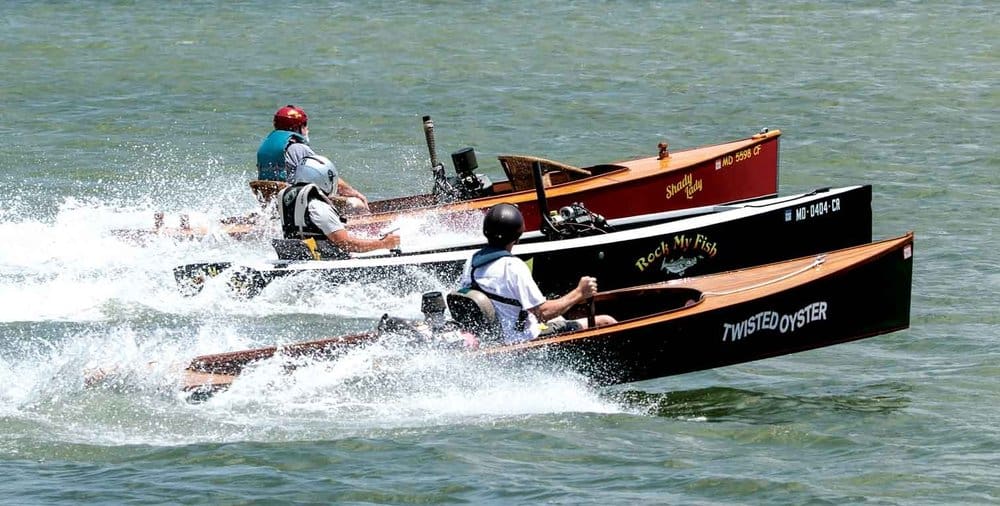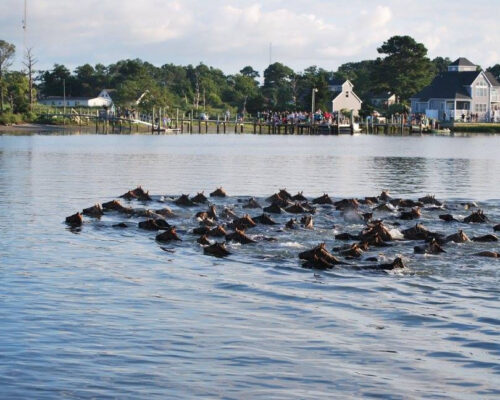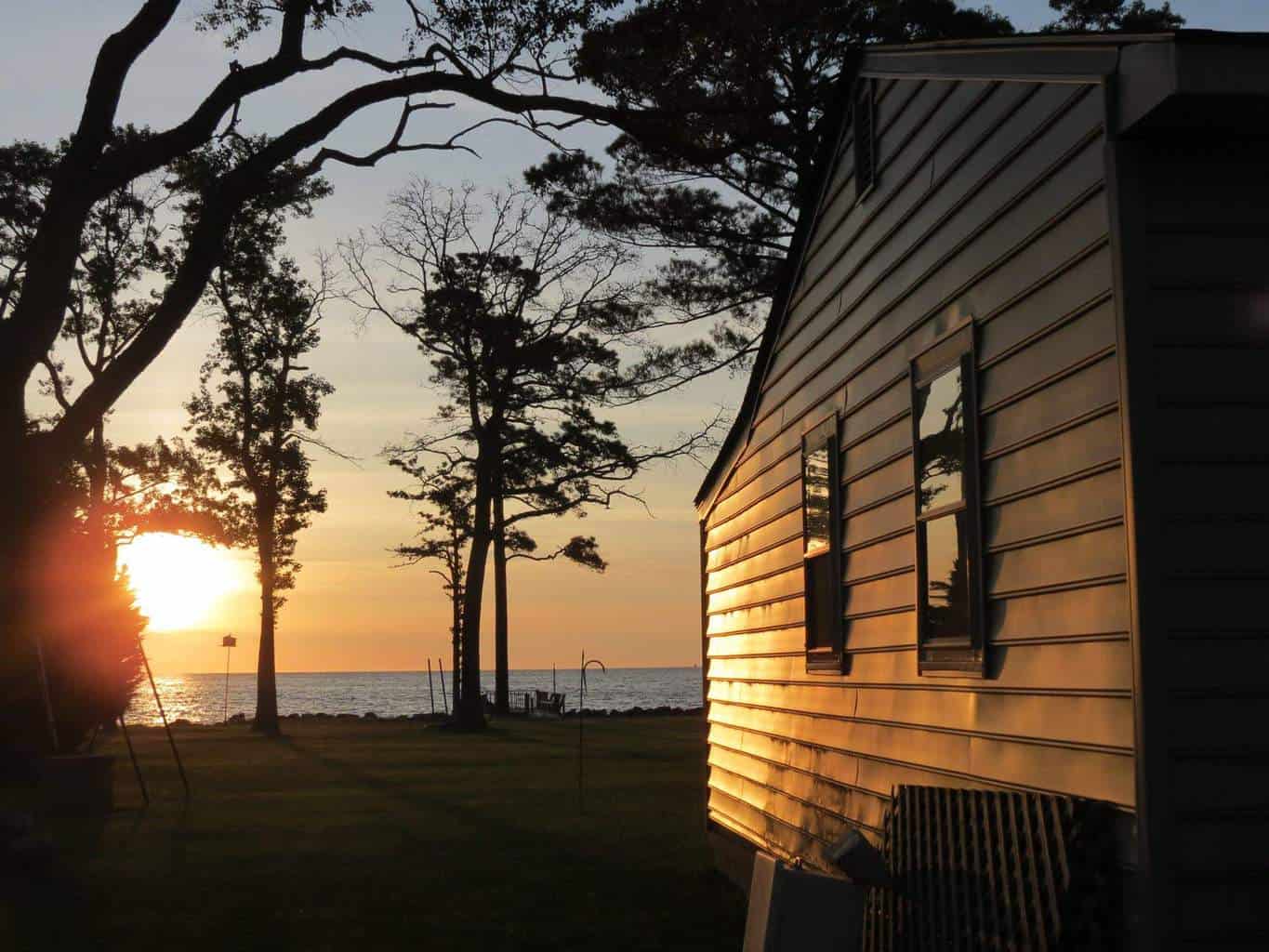Tricked out Smith Island boats race for fun on the Bay.
On a sunny, short-sleeve-warm autumn Saturday, four men of a certain age are standing next to their trailered skiffs at the Mid-Atlantic Small Craft Festival in St. Michaels, showing off their prized possessions to all who pass by. At a show full of varnished handmade kayaks and miniature catboats and schooners, these boats look more like a cross between a rowboat and a dragster. A display board of photos shows off the skiffs in action—racing around buoys, bows raised up in anger, kicking out white water. ¶ These are the members of the Smith Island Crab Skiff Association, and Rick Loheed, the group’s president, is quick to share his enthusiasm for the boats. “I have raced powerboats and sailboats and have my 100-ton Coast Guard license, but racing these boats is the most thrilling thing I have ever done on the water.”
Bob Wallace, of Queenstown, is clearly having a good time as he describes the painstaking process of inlaying the wooden image of a crab on the stern decking of his new skiff. Joe Strohmer, from Crisfield, explains how he built his replica boat out of carbon fiber. And Karl Nisson, of Shady Side, wants it known that the inboard motors were not pirated from garden tractors.
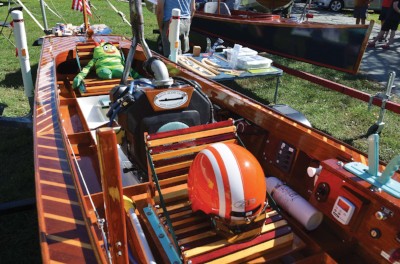
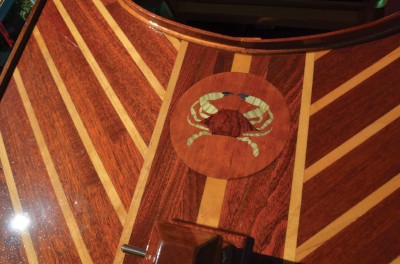
“It’s a 20-horse, 625 cc, V-2, air-cooled utility motor. They are not lawnmower engines,” says Nisson, as he shows off his bright red, traditionally-built wooden skiff Shady Lady. “They are designed for use in industrial compressors.” Whatever their intended purpose, the tricked-out engines mounted amidships in the narrow vessels do look formidable, with their trumpet exhaust pipes and black matte finishes, especially when the race photos show the helmeted racer strapped-in either just aft or inches forward of the engine.
The men trace the lineage of their boats to Captain Lawson “Lawse” Tyler, who built skiffs on Smith Island a hundred years ago. His boats were simple, flat-bottomed vessels big enough to carry a day’s catch but small enough to be handled by a lone waterman. The boats, while generally patterned after earlier sailing skiffs, were designed as powerboats and outfitted with one-lunger, 4-to 6-horsepower inboards, typically Palmers or Grays. Tyler is credited with building his boats with long planks, fastened fore-and-aft, instead of the cross-planked bottom typical of Bay-built watercraft, making the bottom smoother and faster. The boats range from 18 to 20 feet long with a three-and-a-half to four-foot beam and just enough draft to float on the dew. They had a partially covered forepeak to reduce spray and give watermen a place to stand while crabbing with a long-handled dip net. Tyler’s design became so popular that he is believed to have built more than 150 of them into the mid-1930s. One of the last Tyler-built boats is owned by the Calvert Museum and is on loan to the Smith Island Museum
in Ewell.
While racing a crab skiff sounds like a nautical oxymoron, it is a practice that goes back to the boat’s origins. All boat owners know that racing is a naturally occurring, spontaneous action that takes place when two or more captains with similar vessels are in immediate proximity of each other, and the Smith Island watermen were no exception. They ran out to the grassy flats together before dawn to do their work, and when their crab baskets were full and the sun was high, they raced each other back to Ewell or Tylerton for bragging rights at the dock. Local lore even has the quick, little boats serving as lighters for larger rumrunners out on the Bay during Prohibition, off-loading bootlegged liquor and running cases of booze into shallow, isolated coves to dodge the revenuers.
Pete Lesher, chief curator of the Chesapeake Bay Maritime Museum, says the crab skiff’s design was part of the general transition from sail to power that started on the Chesapeake in the early days of the 20th century. “When you see a boat with a plumb stern you know it was designed with more buoyancy in the back to support the weight of a motor,” he says.
The Smith Island Crab Skiff Association is a fairly new group that was formed after Richard “Dickey” White of Oxford, who built a replica crab skiff, challenged another owner from Crisfield to a race at the 1998 Crisfield Crab Derby Regatta.
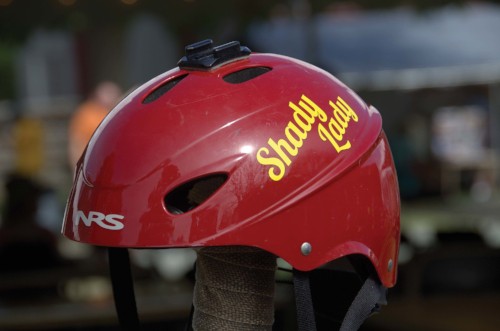
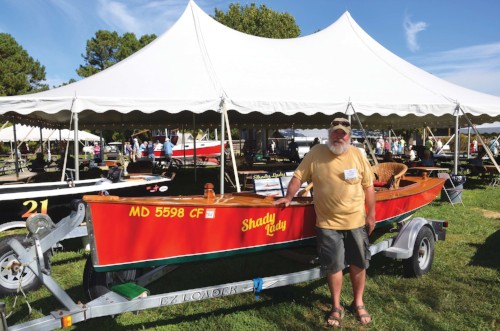
“When they came here for the race, the Crisfield boat beat the stuffins out the Oxford boat,” says Paul Emely, a Somerset County native who owns the skiff Down Necker II and MC’s all of the association races. “I like to call the races for the spectators just like a horse race,” he says. “I give them some description of the boats and their heritage.” The group has about 20 members in Maryland and Virginia, eight to 10 of whom actively race their boats. The organization’s stated goal is, “Keeping a traditional and practical Chesapeake Bay skiff design alive by building, exhibiting and racing these skiffs throughout the area.”
The unstated goal, according to Emely, is “to have fun doing it. It’s a good group and there is a lot of camaraderie. The competition is good but you don’t have to win to have a good time. People enjoy watching the races because we stay pretty much in a pack and the races are usually close.” Emely says the association plans on holding eight races this year at festivals and regattas on both sides of the Chesapeake.
Two early Smith Island Skiffs are on display in the Chesapeake Bay Maritime Museum. One of them was owned by James R. Mills of Dorchester County who bought her in 1938. He used it for years, with his son and grandson, to crab on Hudson Creek off the Little Choptank River. A plaque next to the boat notes, “When the original Palmer engine wore out, Mills took it out and never replaced it, preferring to push the boat through the grassy shallow with his dip net pole while looking for crabs.”
Matt Engel, lead educator for the Chesapeake Bay Maritime Museum, says the simplicity of the skiff’s design is one of the reasons two of them are being built this year as part of the museum’s Rising Tide program, which teaches boatbuilding and woodworking skills to Talbot County school students. The students started off by building scale models of the skiffs so they could get a feel for the three-dimensional techniques needed to build full-sized boats, Engel says. The students were taught how to lift plans for their boats off a hand-drawn sketch of a skiff by master model maker Ed Theiler, of Easton. “It’s a good project to teach intuitive building, rather than just going off a plan from a book,” Engel says.
Over the last two decades, as interest continued to grow in the Smith Island Skiffs, the old Mills boat has become a model for new boats. Nisson says he built Shady Lady in his home workshop using the lines taken from the Mills boat. He says he wanted to build his skiff using traditional methods, but with the aid of modern tools.
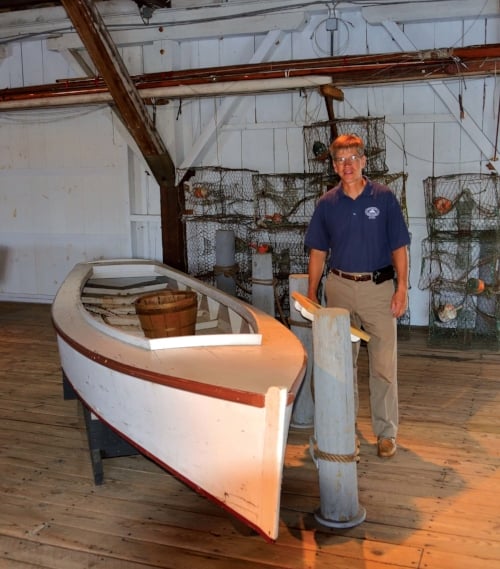
While some builders have followed that path when building their replicas, others have taken a high-tech approach. Loheed’s and Wallace’s skiffs were built from kits made by Loheed’s Twisted Oyster Boatworks in Southern Maryland. Using a computer-assisted router, the parts of the boat were cut from marine-grade plywood and glued together. Wallace says it took about two years working with Nisson to build his Gone Crab Skiff Crazy. He says a lot of extra time went into the fine-finish details including a compass rose inlay on the foredeck to offset the crab at the stern.
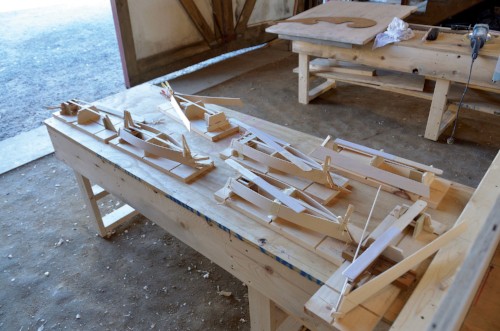
The boats are very similar but each one has the owner’s personalized touch. Loheed’s has molded plastic seats, while Wallace’s are made of high-grade wood. Strohmer’s carbon fiber skiff sports a lightweight tube-and-mesh affair. Nisson, the traditionalist, has fitted out Shady Lady with two modified wicker porch chairs. He says that the original skiff builders used whatever was handy and whatever worked. Some boats are brightly painted and varnished, others are more basic with emphasis put on speed, not polish.
The association has been receiving a fair amount of good publicity in recent years and was featured in a 2016 segment of Maryland Public Television’s “Outdoor Maryland” in a segment called “Crewing a Classic.” In the video, Nisson says when he is asked what kind of boat Shady Lady is, “I tell them it is a pre-World War II personal watercraft.” Several short videos of skiffs being built and racing are also available on Youtube.
Lesher, at the maritime museum, says that the association and its emphasis on racing has kept the class alive and active, much in the same way an active racing schedule has kept the time-honored Chesapeake Bay log canoes in front of the public long after their practical use has faded. “It is spectacular to see,” he says of the skiff races. “They have all of the appeal of other races on land or on water. They are loud, they throw a lot of spray and there is an inherent risk to operating these things. It’s spectacular to see.”

